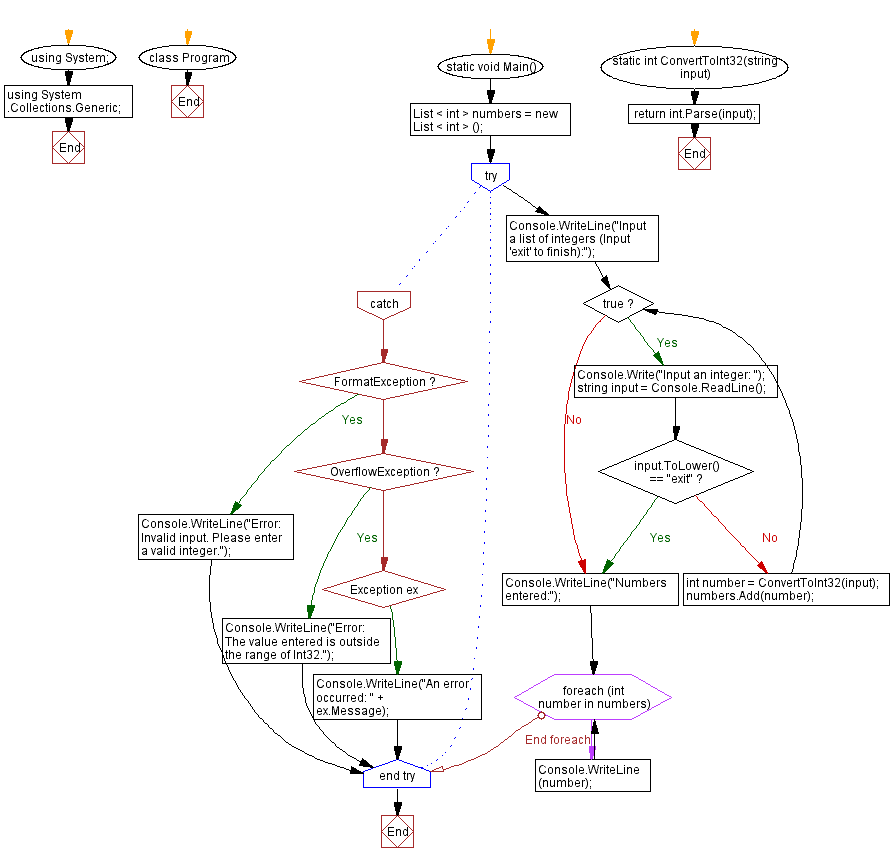C# Program: Read and handle Int32 range exceptions in user input
C# Sharp Exception Handling: Exercise-7 with Solution
Write a C# program that reads a list of integers from the user. Handle the exception that occurs if the user enters a value outside the range of Int32.
Int32 is an immutable value type that represents signed integers with values that range from negative 2,147,483,648 (which is represented by the Int32. MinValue constant) through positive 2,147,483,647 (which is represented by the Int32.
Sample Solution:
C# Sharp Code:
using System;
using System.Collections.Generic;
class Program {
static void Main() {
// Create a list to store integers
List<int> numbers = new List<int>();
try {
// Prompt the user to input a list of integers, enter 'exit' to finish
Console.WriteLine("Input a list of integers (Input 'exit' to finish):");
// Continuously read user input until 'exit' is entered
while (true) {
Console.Write("Input an integer: ");
string input = Console.ReadLine();
// Check if user wants to exit the loop
if (input.ToLower() == "exit")
break;
// Convert user input to an integer and add it to the list
int number = ConvertToInt32(input);
numbers.Add(number);
}
// Display the numbers entered by the user
Console.WriteLine("Numbers entered:");
foreach(int number in numbers) {
Console.WriteLine(number);
}
} catch (FormatException) {
// Catch block for handling FormatException when non-integer input is entered
Console.WriteLine("Error: Invalid input. Please enter a valid integer.");
} catch (OverflowException) {
// Catch block for handling OverflowException when the entered value is outside the range of Int32
Console.WriteLine("Error: The value entered is outside the range of Int32.");
} catch (Exception ex) {
// Catch block for handling other types of exceptions
Console.WriteLine("An error occurred: " + ex.Message);
}
}
// Method to convert string input to an integer
static int ConvertToInt32(string input) {
return int.Parse(input); // Convert string to Int32
}
}
Sample Output:
Input a list of integers (Input 'exit' to finish): Input an integer: 645789 Input an integer: 23451 Input an integer: 123 Input an integer: 12 Input an integer: 1 Input an integer: exit Numbers entered: 645789 23451 123 12 1
Input a list of integers (Input 'exit' to finish): Input an integer: 21474836489 Error: The value entered is outside the range of Int32.
Input a list of integers (Input 'exit' to finish): Input an integer: -2147483649 Error: The value entered is outside the range of Int32.
Explanation:
In the above exercise,
- The Main method initializes a List<int> called numbers to store the integers entered by the user.
- The program prompts the user to enter a list of integers. It continuously reads input from the user using a while loop.
- Within the loop, the program checks if the user entered "exit" (case-insensitive). If so, it breaks out of the loop.
- Otherwise, it calls the ConvertToInt32 method, passing the input as an argument, to convert the input string to an integer.
- The ConvertToInt32 method uses int.Parse to convert the string to an integer. If the input cannot be parsed or if it is outside the range of Int32, a FormatException or an OverflowException is thrown, respectively.
- In the Main method, the exceptions are handled using catch blocks. If a FormatException occurs, it means the input was not a valid integer. The program catches this exception and displays an appropriate error message. If an OverflowException occurs, it means the value entered by the user is outside the range of Int32, and the program handles it accordingly.
- Any other exceptions that may occur are caught by the generic catch block, and a general error message is displayed.
- Finally, the program displays the numbers entered by iterating over the numbers list and printing each element.
Flowchart:

C# Sharp Code Editor:
Improve this sample solution and post your code through Disqus
Previous: Convert user input string to integer with exception handling.
Next: Divide two numbers with exception handling.
What is the difficulty level of this exercise?
Test your Programming skills with w3resource's quiz.
- Weekly Trends and Language Statistics
- Weekly Trends and Language Statistics